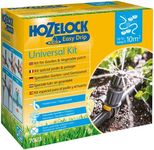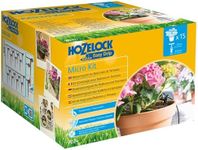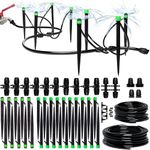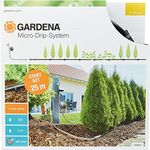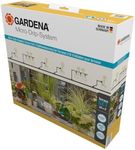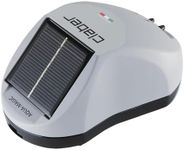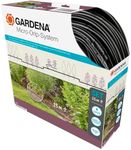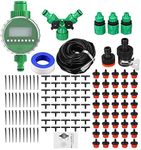Buying Guide for the Best Drip Irrigation Kits
Drip irrigation kits are a great way to efficiently water your garden, saving both time and water. These systems deliver water directly to the roots of plants, reducing evaporation and runoff. When choosing a drip irrigation kit, it's important to consider several key specifications to ensure it meets your gardening needs. Understanding these specs will help you make an informed decision and select the best kit for your garden.Coverage AreaCoverage area refers to the total space that the drip irrigation kit can effectively water. This is important because you need a kit that can cover the entire area of your garden or specific sections you want to irrigate. Kits typically range from small areas (up to 100 square feet) to large areas (over 1,000 square feet). To pick the right one, measure the size of your garden and choose a kit that matches or exceeds this area.
Water Flow RateWater flow rate is the amount of water delivered by the system over a specific period, usually measured in gallons per hour (GPH). This spec is crucial because different plants have different water needs. Low flow rates (up to 1 GPH) are suitable for plants that require minimal water, while higher flow rates (over 2 GPH) are better for plants that need more water. Consider the types of plants in your garden and their water requirements when choosing a kit.
Emitter TypesEmitters are the components that release water to the plants. There are various types, including drip emitters, micro-sprinklers, and bubblers. Drip emitters provide a slow, steady drip, ideal for deep-rooted plants. Micro-sprinklers cover a larger area and are suitable for ground cover or lawns. Bubblers release more water and are good for trees and shrubs. Choose emitters based on the specific needs of your plants and garden layout.
Tubing MaterialTubing material is the type of hose used to transport water from the source to the emitters. Common materials include polyethylene, PVC, and rubber. Polyethylene is flexible and easy to install, PVC is durable and resistant to damage, and rubber is highly flexible and can withstand extreme temperatures. Consider the climate and conditions of your garden to select the most suitable tubing material.
Pressure RequirementsPressure requirements refer to the water pressure needed for the system to function properly, usually measured in pounds per square inch (PSI). This is important because insufficient pressure can lead to poor water distribution. Kits typically require between 10 to 30 PSI. Check your water source's pressure and ensure it matches the kit's requirements. If your pressure is too low, you may need a pressure regulator.
Ease of InstallationEase of installation is how simple it is to set up the drip irrigation kit. Some kits come with detailed instructions and require minimal tools, while others may be more complex. If you're new to drip irrigation, look for kits labeled as 'easy to install' or 'beginner-friendly.' Consider your comfort level with DIY projects and choose a kit that matches your skills.
ExpandabilityExpandability refers to the ability to add more components to the system in the future. This is important if you plan to expand your garden or add more plants. Some kits are modular and allow for easy expansion, while others are fixed and cannot be modified. If you anticipate growing your garden, choose a kit that offers expandability options.
